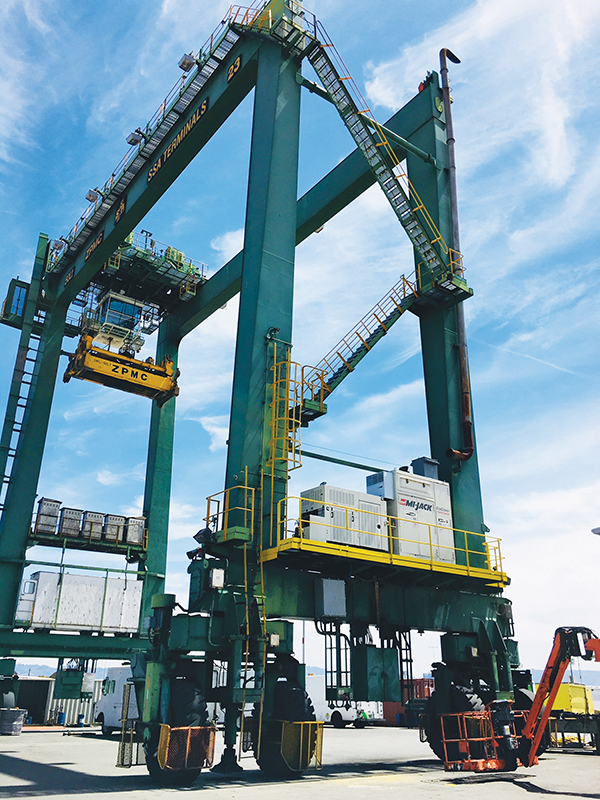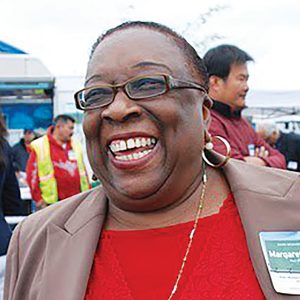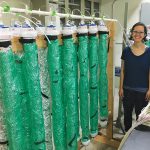
Retrofitted gantry cranes are the first step toward a zero-emission future at the Port of Oakland. Photo courtesy the Port of Oakland.
In 2018, the Port of Oakland handled over 2.5 million cargo containers, making it the eighth-busiest port in the U.S. All that activity gives the Bay Area an enormous economic boost — the Port and its business partners provide 84,000 jobs in Northern California — but at a significant environmental cost. “The traditional source of power for Port of Oakland operations is diesel,” said Port Community Affairs Manager Laura Arreola, and the resulting high levels of air pollution have affected the neighboring West Oakland community for decades.
However, advances in technology offer the opportunity to improve that unhealthy situation. As Arreola observed, “The seaport industry is a microcosm of the energy choices that are also happening in the wider community, including looking at renewable energy sources.” The Board of Port Commissioners endorsed such cleaner choices in June by adopting the Seaport Air Quality 2020 and Beyond Plan, which puts the facility on a pathway to zero emissions over the course of the next 30 years, shifting it completely off fossil fuels.
A first step toward this zero-emissions future is already on display in the form of three low-emission rubber-tired gantry cranes, which exert a 50-ton lift capacity to move containers onto trucks. Installed recently by terminal operator SSA, the retrofitted gantries use battery-powered hybrid engines that consume about a half-gallon of fuel per hour, as compared to 10-12 gallons per hour for their all-diesel counterparts. “There’s no smokestack,” Arreola said about the cleaner-running machines, which are also “so quiet!”
SSA plans to retrofit ten more cranes by next June. The Port estimates that the 13 retrofitted cranes will eliminate 45 tons per year of diesel-related pollutants.
Since 2009, the Port has had a Maritime Air Quality Improvement Plan aimed at reducing diesel particulate matter, and emissions inventories show a steep decrease from the 2005 base year. However, that plan assumed the ongoing use of fossil fuels and relied on gradual improvements in engine technology to reduce diesel particulate matter. Despite the progress over the past decade, community and environmental groups working on local air monitoring plans have continued to voice concerns about particulates from Port-related activities, and the Bay Area Air Quality Management District has determined that there are significant and unacceptable health inequities in West Oakland.
Where the earlier plan dealt with known factors — fuel, infrastructure, regulations — to reach a specified decrease in emissions by a specified date, the new plan stretches into a less predictable future. It assumes that new technologies now coming into use will mature into reliable and durable equipment, that infrastructure can be designed and implemented to meet a significant new power demand, and that future regulations and compliance deadlines will not be incompatible with the plan’s projected targets and schedules.
To accommodate some of the uncertainty, the plan is divided into phases that will end in 2023, 2030, and 2050. In the first two phases, programs and projects to reduce emissions will include measures such as switching to renewable diesel or converting vehicles to electric battery power, and retrofits for rubber-tired gantries like those already in use, as well as reducing emissions from vessels and harbor craft.
The shift to zero-emissions equipment and operations will begin quickly as well, and will initially stress actions that provide larger reductions in toxic air contaminants, take effect sooner, or can be targeted locally. Some early measures — for example, developing battery-powered equipment demonstration projects — will help to define how to best meet the zero-emissions goal in later phases.
The plan assumes that the predominant Port power source in the future will be electricity, and this shift will require upgrading and adding infrastructure, and increasing resiliency with back-up systems. It will be implemented in partnership with terminal operators and tenants as well as in coordination with PG&E, which supplies power to part of the Port area.
There are three critical factors for the plan’s success: technology, funding, and partnerships. While the technology might seem the most daunting issue, advances are already being made around the globe in port equipment and facility operations, and battery storage for renewable energy is becoming easily available. Likewise, tighter state regulations have been accompanied by increased agency funding that can assist the Port and associated businesses to meet those regulations, with grants aimed at upgrades for heavy-duty equipment like trucks, terminal vehicles, and gantries to cleaner hybrid or all-electric models. SSA’s gantries are being purchased with the help of a grant from the Air District.
Perhaps the biggest challenge will be creating strong partnerships and continuing extensive stakeholder engagement. The Port is not a monolithic entity. It functions as the nexus of a diverse group of stakeholders: terminal operators, other tenants, maritime trade associations, truckers, neighborhood businesses and residents, and the broader Bay Area community which is affected by transportation and environmental impacts of Port operations.
All of these stakeholders have their own often conflicting expectations and concerns about the plan. The Port reactivated a stakeholder task force that worked on the 2009 plan, convening six task force meetings between February 2018 and April 2019. And in total, almost 350 comments on the initial and revised drafts of the 2020 plan were cataloged for response.
The Pacific Merchant Shipping Association and other Port-related businesses strongly criticized the first draft over the potential burden of specific proposed changes and deadlines, but John Berge, a PMSA vice president, said recently, “Nothing has been adopted that has been set in stone.” In his view, “It’s a very aggressive and ambitious plan that puts a lot of pressure on our industry. The state and the Air Quality District have already set a timeline of regulations, and the Port is trying to meet that and provide funding assistance. Our industry is ready to work with it.”
Margaret Gordon, a longtime activist with the West Oakland Environmental Indicators Project, considers the new plan to be the next achievement in an incremental process of building improved relationships among the West Oakland community, the Air District, and the Port. “WOEIP collectively developed allies to get the Port to develop the plan, to create the pathway to zero emissions,” she said. Her organization used air monitoring and modeling provided by the Air District for ongoing West Oakland community air quality improvement planning to help shape the Port plan.

Activist Margaret Gordon has advocated for cleaner air in West Oakland for many years. Photo courtesy West Oakland Environmental Indicators Project.
The Environmental Defense Fund provided extensive comments on the first draft of the plan, but although changes were made in the stakeholder engagement strategy, EDF’s Fern Uennatornwaranggoon reported that her organization felt the Port was “insufficiently responsive” to their request for more specific goals and objectives. “They didn’t budge,” she said, and EDF didn’t comment on the final draft. EDF is still active in West Oakland community air quality monitoring planning and intends to participate in ongoing Port stakeholder opportunities.
Before the plan was adopted, Uennatornwaranggoon felt that, while there is a valid argument that the Port needs to remain competitive, “They don’t see themselves as industry leaders — they could be pushing the market. Instead, there’s a lot of ‘we need to do studies’, a lot of ‘wait and see’.”
The Board of Port Commissioners did respond when stakeholders criticized the plan as comparing unfavorably to efforts at the ports of Los Angeles and Long Beach. Commission amendments added six-month feasibility reports on putting all 300 pieces of cargo-handling equipment and all 8,000 Port-servicing trucks on a full conversion path — matching plans for the southern ports — and on electric capacity needs.
Commissioners also agreed with the request for more specifics earlier in the implementation process. Instead of the original 5-year evaluation point, the Port now plans 6-month and 1-year lookbacks. Arreola said, “We’ll look at what measures actually got the green light in our screening process — which ones proved themselves.”
For Berge, the schedule for ongoing assessment provides both checkpoints and the flexibility to make changes based on experience. He noted this will be an open process, and expects good stakeholder involvement. Stakeholders will also have a role in the screening of proposed implementation measures as the plan is implemented.
“We’re just at the beginning, but we have a lot of details to keep moving ahead, to move the needle,” Gordon stated. “We have enough allies who are on board with the plan, who understand it, to see it through in the next stages.”

